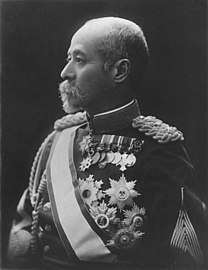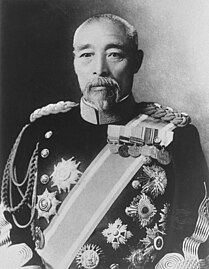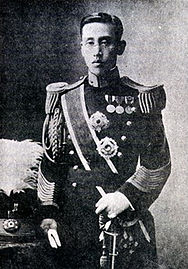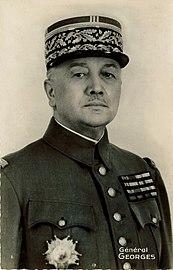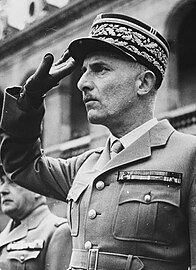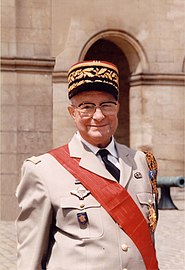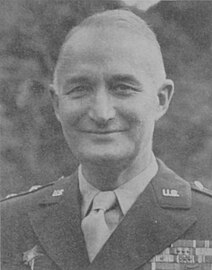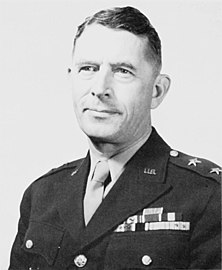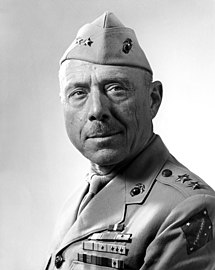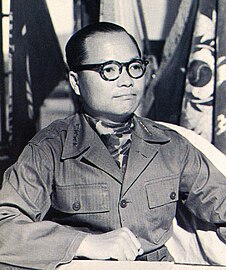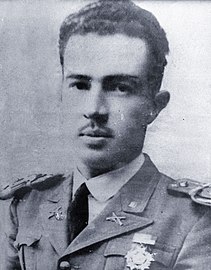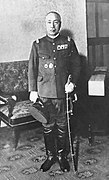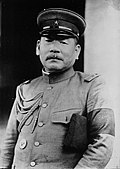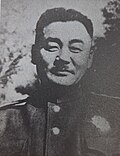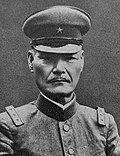Gangbaek Theater: Difference between revisions
BattlerNonna (talk | contribs) mNo edit summary |
BattlerNonna (talk | contribs) mNo edit summary |
||
| Line 6: | Line 6: | ||
| image_size = 300px | | image_size = 300px | ||
| alt = | | alt = | ||
| caption = Joyonghan troops at the [[Battle of Mount Haebaek]] during the [[ | | caption = Joyonghan troops at the [[Battle of Mount Haebaek]] during the [[Battle of Musudal]], 21 January 1942 | ||
| date = 1937{{snd}}1945 | | date = 1937{{snd}}1945 | ||
| place = [[Gangbaek Archipelago]] | | place = [[Gangbaek Archipelago]] | ||
| Line 78: | Line 78: | ||
After the [[Tansong Islands Campaign|Tansong Islands]] were occupied by the Imperial Quenminese Army under the command of Marshal [[Chử Duy Thắng Hiển]], Marquis of Hue Cai-Tân Giá, the Imperial General Staff ordered him to invade [[Namdong]] of the Gangbaek Archipelago. In 7 September 1937, Marshal Hiển made landfall in Southern [[Namdong]] and took the island by the end of October. In 2 October, the province of [[Hamyong Province|Hamyong]] fell to the Quenminese, and the [[Hamyong Government]] was formed by disgruntled government officials that betrayed the Joyonghean government with Quenminese political and military support, with [[Mangjeol Jun-iseul]] taking position as Prime Minister. From 1 November 1937 to 15 March 1938, the entirety of South [[Nanja]] fell to the Quenminese after much defense by the Joyonghean 16th Army and the 2nd Gangbaek Provincial Army. In April 1938, the [[Holy Trabian Empire]] sent a token force under the command of [[Maxence Nathanaël Baillairgé]], Count of Colluçon-Vieryonne, namely the [[Holy Trabian Army of Gangbaek]], to provide assistance. Six months later, the [[Chongpyong Offensive]] proved another setback for the Joyongheans after two and a half weeks of fighting, however they stood against the first Quenminese encirclement campaign against [[South Pyongan Province]]. The victory was short-term as Quenmin's success in the [[Heungsang Landings]] and the [[Ragweon Campaigns]] led to South Pyongan being taken. The [[Battle of Changheung]] in August 1940 led to the Quenminese advance further north, tightening the containment of the Joyongheans and Trabians in the south with the vessels from the Imperial Quenminese Navy in the north. | After the [[Tansong Islands Campaign|Tansong Islands]] were occupied by the Imperial Quenminese Army under the command of Marshal [[Chử Duy Thắng Hiển]], Marquis of Hue Cai-Tân Giá, the Imperial General Staff ordered him to invade [[Namdong]] of the Gangbaek Archipelago. In 7 September 1937, Marshal Hiển made landfall in Southern [[Namdong]] and took the island by the end of October. In 2 October, the province of [[Hamyong Province|Hamyong]] fell to the Quenminese, and the [[Hamyong Government]] was formed by disgruntled government officials that betrayed the Joyonghean government with Quenminese political and military support, with [[Mangjeol Jun-iseul]] taking position as Prime Minister. From 1 November 1937 to 15 March 1938, the entirety of South [[Nanja]] fell to the Quenminese after much defense by the Joyonghean 16th Army and the 2nd Gangbaek Provincial Army. In April 1938, the [[Holy Trabian Empire]] sent a token force under the command of [[Maxence Nathanaël Baillairgé]], Count of Colluçon-Vieryonne, namely the [[Holy Trabian Army of Gangbaek]], to provide assistance. Six months later, the [[Chongpyong Offensive]] proved another setback for the Joyongheans after two and a half weeks of fighting, however they stood against the first Quenminese encirclement campaign against [[South Pyongan Province]]. The victory was short-term as Quenmin's success in the [[Heungsang Landings]] and the [[Ragweon Campaigns]] led to South Pyongan being taken. The [[Battle of Changheung]] in August 1940 led to the Quenminese advance further north, tightening the containment of the Joyongheans and Trabians in the south with the vessels from the Imperial Quenminese Navy in the north. | ||
From January to May 1941, stalemate ensued with the Joyongheans and Trabians stalling the Quenminese advance, and they held initial success during the [[Chagang Campaign]] until the Quenminese got the upper hand. In June 1941, the [[Concordia and the Soryu|Concordians]] under Gen. [[Thomas C. Metcalfe]] entered into Northern Nanja after the [[Royal Concordian Navy]] secured their landing. From late 1941 to early 1942, Allied forces made headway southwards until approaching [[Musudal]] in March 1942. The [[ | From January to May 1941, stalemate ensued with the Joyongheans and Trabians stalling the Quenminese advance, and they held initial success during the [[Chagang Campaign]] until the Quenminese got the upper hand. In June 1941, the [[Concordia and the Soryu|Concordians]] under Gen. [[Thomas C. Metcalfe]] entered into Northern Nanja after the [[Royal Concordian Navy]] secured their landing. From late 1941 to early 1942, Allied forces made headway southwards until approaching [[Musudal]] in March 1942. The [[Battle of Musudal]] proved a decisive turning point for the Allies, as the Quenminese lost a vital strategic city that consolidated their holdings in the north. In late 1942, the Quenminese force the Allies into a stalemate until mid-1943, at the time of the entry of the [[Equatorial Amerigonna|Ecuatorials]]. The [[South Hamgyong Campaign]] proved an arduous venture as General Viscount [[Nguyễn Quang Minh Thạc]] executed a series of well-organized counterattacks against the Allies, but eventually turned upside down with the Joyongheans making criticial strategic moves that regain them the province. 1944 observed Allied successes in the [[Hwanghae-Poseon Campaign]], [[Siege of Chaeryeong]], and the decisive [[Battle of Rucheol and Chuktong]]. By early 1945, although hard-fought, the Allies regained Namdong, permanently removing Quenminese presence from the Gangbaek Archipelago. | ||
The Allied victory in the theater proved consequential for the [[Mainland Theater of the Third Joyonghean-Quenminese War]], as Quenminese forces under Marshal [[Hồ Danh Sĩ Quốc]] were cut off from the south and compelled to reside north, which precipitated the formation of the [[Bằc Lạnh Provisional Government]] during the [[Post Second Europan War Crisis of 1945]]. | The Allied victory in the theater proved consequential for the [[Mainland Theater of the Third Joyonghean-Quenminese War]], as Quenminese forces under Marshal [[Hồ Danh Sĩ Quốc]] were cut off from the south and compelled to reside north, which precipitated the formation of the [[Bằc Lạnh Provisional Government]] during the [[Post Second Europan War Crisis of 1945]]. | ||
Revision as of 07:25, 27 April 2024
The Gangbaek Theater, also known as the Eastern Theater of the Jeongchuk War and the Gangbaek Strategic Offensive Campaign, was a theater of the Third Joyonghean-Quenminese War situated in the Gangbaek Archipelago, which contains the contemporary nation of the Nanja Republic.
After the Tansong Islands were occupied by the Imperial Quenminese Army under the command of Marshal Chử Duy Thắng Hiển, Marquis of Hue Cai-Tân Giá, the Imperial General Staff ordered him to invade Namdong of the Gangbaek Archipelago. In 7 September 1937, Marshal Hiển made landfall in Southern Namdong and took the island by the end of October. In 2 October, the province of Hamyong fell to the Quenminese, and the Hamyong Government was formed by disgruntled government officials that betrayed the Joyonghean government with Quenminese political and military support, with Mangjeol Jun-iseul taking position as Prime Minister. From 1 November 1937 to 15 March 1938, the entirety of South Nanja fell to the Quenminese after much defense by the Joyonghean 16th Army and the 2nd Gangbaek Provincial Army. In April 1938, the Holy Trabian Empire sent a token force under the command of Maxence Nathanaël Baillairgé, Count of Colluçon-Vieryonne, namely the Holy Trabian Army of Gangbaek, to provide assistance. Six months later, the Chongpyong Offensive proved another setback for the Joyongheans after two and a half weeks of fighting, however they stood against the first Quenminese encirclement campaign against South Pyongan Province. The victory was short-term as Quenmin's success in the Heungsang Landings and the Ragweon Campaigns led to South Pyongan being taken. The Battle of Changheung in August 1940 led to the Quenminese advance further north, tightening the containment of the Joyongheans and Trabians in the south with the vessels from the Imperial Quenminese Navy in the north.
From January to May 1941, stalemate ensued with the Joyongheans and Trabians stalling the Quenminese advance, and they held initial success during the Chagang Campaign until the Quenminese got the upper hand. In June 1941, the Concordians under Gen. Thomas C. Metcalfe entered into Northern Nanja after the Royal Concordian Navy secured their landing. From late 1941 to early 1942, Allied forces made headway southwards until approaching Musudal in March 1942. The Battle of Musudal proved a decisive turning point for the Allies, as the Quenminese lost a vital strategic city that consolidated their holdings in the north. In late 1942, the Quenminese force the Allies into a stalemate until mid-1943, at the time of the entry of the Ecuatorials. The South Hamgyong Campaign proved an arduous venture as General Viscount Nguyễn Quang Minh Thạc executed a series of well-organized counterattacks against the Allies, but eventually turned upside down with the Joyongheans making criticial strategic moves that regain them the province. 1944 observed Allied successes in the Hwanghae-Poseon Campaign, Siege of Chaeryeong, and the decisive Battle of Rucheol and Chuktong. By early 1945, although hard-fought, the Allies regained Namdong, permanently removing Quenminese presence from the Gangbaek Archipelago.
The Allied victory in the theater proved consequential for the Mainland Theater of the Third Joyonghean-Quenminese War, as Quenminese forces under Marshal Hồ Danh Sĩ Quốc were cut off from the south and compelled to reside north, which precipitated the formation of the Bằc Lạnh Provisional Government during the Post Second Europan War Crisis of 1945.
Background
Opposing forces
Allied
| Key commanders (Army Group Gangbaek) |
|---|
|
| Key commanders (Holy Trabian Army of Gangbaek) |
|---|
|
| Key commanders (Royal Concordian Expeditionary Force Gangbaek) |
|---|
|
| Key commanders (Ecautorial Expeditionary Army to Joyonghea) |
|---|
|
Imperial
| Key commanders (Gangbaek Imperial Front) |
|---|
|


